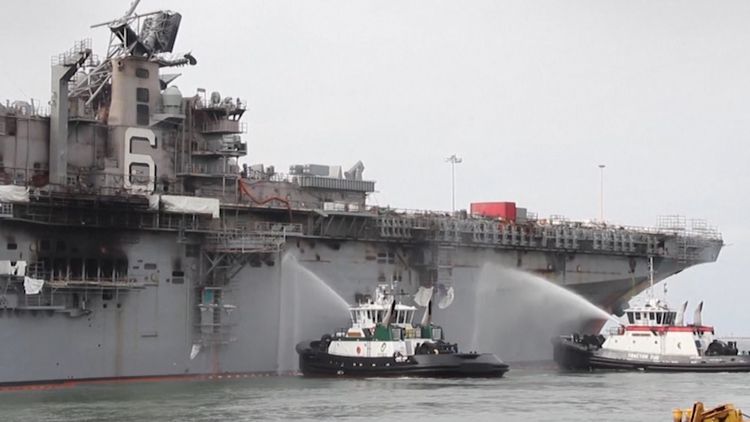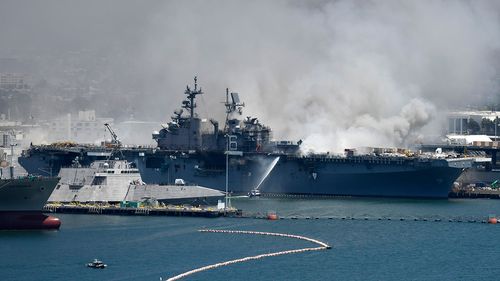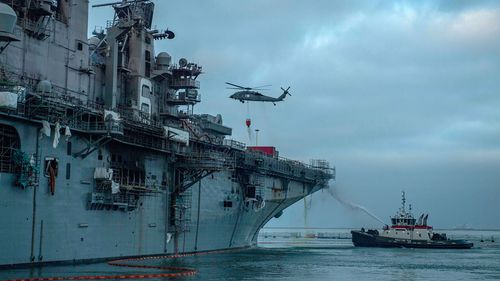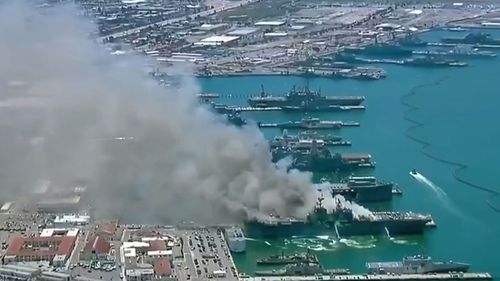A massive blaze aboard a billion-dollar US Navy warship has been extinguished after raging for four days – but its effect might be felt across America’s Pacific Fleet for years.

Navy officials said the fire aboard the USS Bonhomme Richard, an amphibious assault ship undergoing maintenance and upgrades at a port in San Diego, was put out last Thursday.
Reaching temperatures up 650 degrees Celsius, it melted aluminium and incinerated wiring, plastics and combustibles like drywall, bedding and office supplies, while filling the 260-metre vessel with thick smoke.

The true extent of the damage, however, remains unknown. Engineers will need to get into the ship to assess the destruction once the spaces inside cool down, officials said.
The Navy’s top officer, Admiral Mike Gilday, said there would be a thorough investigation of the fire’s cause.
“We will fully investigate what happened here so that we learn all that we can from this terrible tragedy,” Mr Gilday said.
“It is too early to make any predictions or promises of what the future of the ship will be,” Rear Admiral Philip Sobeck, commander of the Navy’s Expeditionary Strike Group Three, said.
“Whether or not it will be repaired will be determined.”
Either way, the long-term impacts are significant.

The Bonhomme Richard, which resembles a baby aircraft carrier, was being upgraded to accommodate some of the newest and most sophisticated warplanes in the US arsenal, Marine Corps F-35Bs.
It was to be one of only four ships in the US fleet with the ability to handle the F-35Bs – meaning its absence will be felt.
“As tensions mount with China in the South China Sea, as well as with North Korea, the loss of this ship and her capabilities will make it more difficult for the Navy to meet all its war-fighting requirements,” military analyst and former US Navy admiral John Kirby said.
Timothy Heath, senior international defence researcher at the Rand Corporation, said deploying F-35s continuously in the Indo-Pacific region would have served as a visible reminder of the US military’s technological edge over rivals such as China.
“The advanced capabilities of the F-35 outclass those of any Chinese fighter, providing an edge in air-to-air combat,” Mr Heath said.
“The US Navy’s effort to operate expeditionary task forces with F-35s on a continuous basis in the Indo-Pacific will be dealt a serious blow.”
The long-term consequences
For now, the USS America – a newer version of the amphibious assault ship capable of deploying F-35s – is filling in for the Bonhomme Richard, operating out of the US Navy base in Sasebo, Japan.

Naval commanders pointed out that the USS Tripoli, the Navy’s newest amphibious assault ship, was commissioned on Wednesday, joining the fleet as the 22-year-old Bonhomme Richard burned.
But the absence of any ship can take a toll.
“There are always follow-on effects when a ship is unexpectedly removed from service,” former director of operations at the US Pacific Command’s Joint Intelligence Centre, Carl Schuster said.
“The Bonhomme Richard was supposed to return to the fleet this fall, freeing up another to receive needed maintenance and upgrade.
“Now, that is not going to happen. So, another ship’s maintenance and upgrade needs will be delayed, and a capability gap opened.”
This is likely to cause a snowball effect, Mr Heath said.
“The US military will have to cut back on the missions it takes on, or it will need to stress the remaining crews to meet its obligations. Both carry risks,” he said.
“Cutting back on operations by US expeditionary task forces may leave gaps in the US Navy’s operational presence, which could embolden countries like China to step up coercive measures.
“However, stressing crews by cutting back on maintenance, rest … raises the risk of further mishaps and disasters. Both could further injure US credibility in the region.”
Although the Navy has not yet been able to determine the cause of the blaze on the Bonhomme Richard, losing a major war-fighting platform to a pier-side fire raises questions about whether procedures were properly followed.
Mr Heath said the Navy has been grappling with credibility concerns in the Pacific for years – including the 2017 collisions that left the destroyers USS Fitzgerald and USS John McCain out of commission for more than two years each.
Crew fatigue, training deficiencies and failure to follow procedures played a part in those accidents, which left a combined 17 US sailors dead, according to Navy investigations.
More recently, the Navy had one of its Pacific aircraft carriers, the USS Theodore Roosevelt, out of action for weeks at its base in Guam after an outbreak of COVID-19 infected more than 1000 crew, killing one sailor.
Its commander was later relieved of duty for not following protocols to prevent the virus from spreading on his ship.
“By itself, the (Bonhomme Richard) disaster may have been merely unfortunate, but it occurred after a series of mishaps with the US Navy in the Indo-Pacific,” Mr Heath said.
“With US national level messaging about alliances inconsistent and erratic, these setbacks in the US Navy become even more damaging to US credibility in the region.”
Indeed, in the days before the fire in San Diego, the Navy was touting how it had overcome COVID-19 to stage South China Sea exercises involving two aircraft carriers and more than 12,000 troops for the first time in six years.
“We’ve taken extraordinary measures to protect our sailors from COVID-19,” Rear Admiral George Wikoff, commander of Carrier Strike Group 5, led by the USS Ronald Reagan, said.
Messages and perceptions
Former director of operations at the US Pacific Command’s Joint Intelligence Centre, Carl Schuster said the dual-carrier exercise in the South China Sea was designed to send a message to Beijing.
“The US Navy is back following the COVID-19-driven reduced activity,” Mr Schuster said.
The Navy said the exercises showed its commitment to allies in the region, too.
Yet the loss of one of its baby carriers could lead allies to question whether Washington can sustain its commitment.
“What exercises and other plans do we reduce or cancel outright? Those decisions will impact perceptions of our commitment and capability,” Mr Schuster said.
Back in Washington, there will also be financial concerns. The Bonhomme Richard cost about US$750 million (A$1.07 billion) to build and was undergoing a few hundred-million-dollar improvements to ready it for F-35s.
Mr Schuster said repairs would likely cost at least $US150 million (A$214 million).
By comparison, the Navy spent more than US$500 million (A$715 million) to repair and update the smaller destroyer Fitzgerald after its collision with a cargo ship off Japan in 2017, the US Naval Institute reported.
A new amphibious assault ship, like the Tripoli, costs about US$3.4 billion (A$4.9 billion), according to the US Government Accountability Office.
Despite all the problems the fire on the Bonhomme Richard has created, Mr Kirby said they can be overcome.
“My goodness, if our strategy in any given part of the world hinges on the availability of one particular ship, well, we’ve got much bigger fish to fry,” Mr Kirby said.





